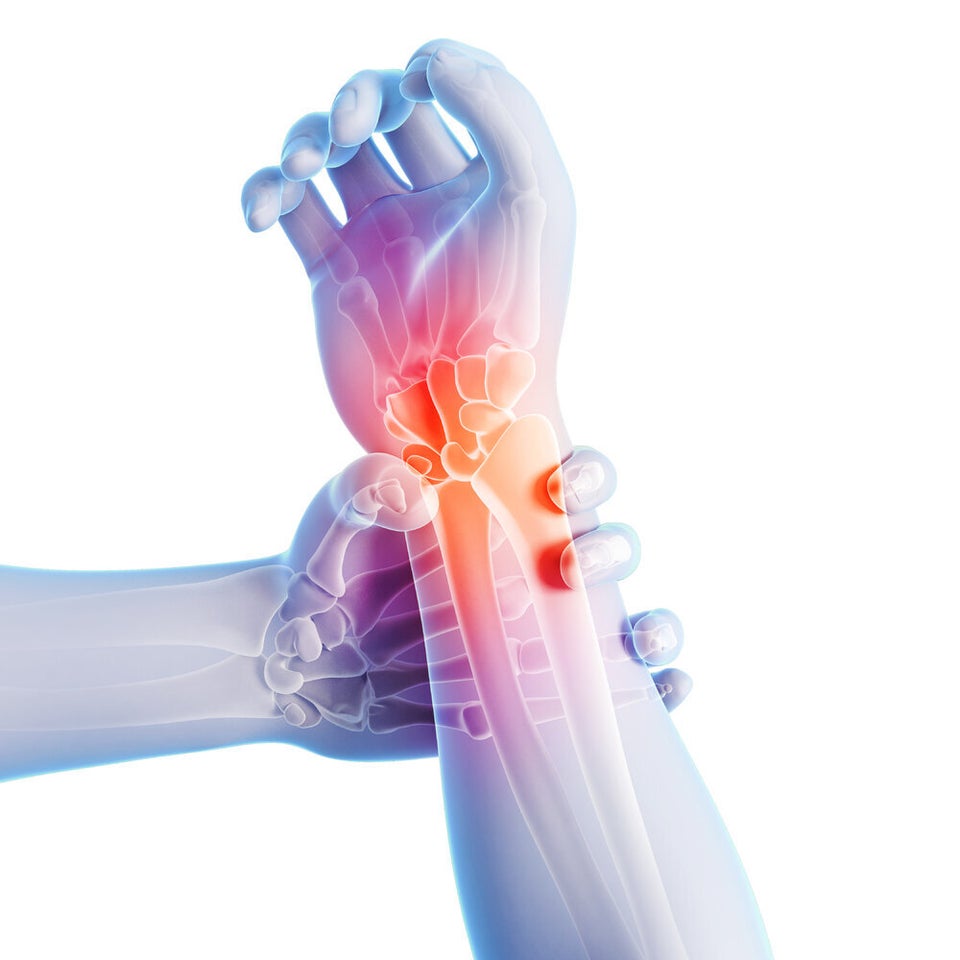
It starts with tingling and can end in a wrist splint.
Carpal tunnel syndrome (CTS) is a condition that leaves wrists in pain, inflamed and numb, according to Sherry Torkos, author of The Canadian Encyclopedia of Natural Medicine.
But causes of CTS start almost on the surface. Often, it begins with pressure on the median nerve, the only nerve that runs through the carpal tunnel of the forearm and up past the upper limb and into your neck. Think about it: Our nerves and blood vessels are delicate pieces of tissue that have an important role in our bodies and, as Torkos adds, any type of pressure can cause damage.
And sometimes, it's not you — it's your workplace. Even though there aren't exact numbers of how many people suffer from CTS each year, the Canadian Canadian Centre for Occupational Health and Safety (CCCOHS) says studies have shown that some occupations have a higher chance of developing the condition.
One study found that 614 out of 982 grocery store cashiers reported symptoms of CTS, while another report found that out of a group of 788 meat handlers, 117 had surgical treatment for CTS over a 12-year period, according to the CCCOHS. The organization also found that farmers, painters, assembly line workers, janitors and office workers are at the highest risk of developing pain.
But Torkos adds that CTS can easily be preventable — as long as you're eating healthy and giving your wrists a break. Food can in fact prevent common symptoms of CTS by helping your nerves function, with ingredients like beans, bananas, egg yolk and whole grains all playing a part. She adds that supplements like fish oil and vitamin B6 can also help with sensitive and sore wrists.
And we already know sitting at a desk all day is killing us, but Torkos says typing all day can be killing your wrists. If you work in a office, take a break every 20 minutes, use ergonomic equipment, schedule in a massage and keep your posture straight.
CORRECTION: This article has been updated from a previous version.
But how do you know if you have even CTS? Here are 17 things you may not know about the condition:
Signs & Symptoms: Your Wrists Are On Fire:
HOW YOU FEEL: Common signs of carpal tunnel syndrome (CTS) often start with light pain that can gradually get worse over time, according to Sherry Torkos, author of the The Canadian Encyclopedia of Natural Medicine. Torkos says you may feel aching in the wrists that can extend up the arms, or in your palms and fingers.
Signs & Symptoms: The Tingling Sensation:
HOW YOU FEEL: Pain is one thing, but your fingers and palms may also start to feel differently. Torkos says you may feel numbness and tingling or sometimes, even weakness in your hands while doing everyday tasks.
Risk Factors: Chronic Conditions:
WATCH FOR: Chronic conditions, like diabetes or alcoholism can increase the risk of nerve damage, Torkos says.
Risk Factors: Gender Matters:
WATCH FOR: Women are three times more likely to get CTS, because the actual carpal tunnel (the passageway near your wrist) is smaller in women, Torkos says.
Risk Factors: Injuries Hurt...And Suck:
WATCH FOR: If you've already had an injury, your risk of developing CTS can increase. Any form of stress or force placed in the wrist area, dislocations or fractures can all add excess pressure on your nerves, Torkos says.
Risk Factors: Repetitive Use Of Wrists:
WATCH FOR: Working away on that keyboard all day? Your wrists aren't too happy with you. Torkos says any type of repetitive routine including working on computers, machinery, assembly lines or even power tools can put a strain on your wrists.
Natural Prescription: Make A Grocery List:
TO BUY: And here's some food for thought: Torkos says certain types of foods can improve your nerve functions. So the next time you hit the grocery store, make sure you add beans, brewer's yeast, bananas, egg yolk, walnuts and whole grains to your shopping list.
Natural Prescription: Eat Fish:
TO BUY: Fish that contain omega-3 fatty acids (like salmon) provide anti-inflammatory properties that can also aid nerve function, Torkos says.
Natural Prescription: Fruits And Veggies:
TO BUY: If you've already developed CTS, Torkos says eating vegetables and fruits (both have vital antioxidants and nutrients) can speed up the healing process and reduce inflammation.
Recommended Supplements: Fish Oil:
TO BUY: And if you're not a fan of fish, Torkos says you can get away with fish oil supplements. The antioxidants and omega-3 fatty acids found in fish oil can help improve the symptoms of CTS.
Recommended Supplements: B6:
TO BUY: Vitamin B6 can reportedly reduce the pain and symptoms of CTS, according to Torkos. However, she notes, people shouldn't consume over 500 mgs of vitamin B6 in a day — an overload can cause damage to your sensory nerves.
Foods To Avoid: Salt And More Salt:
WATCH OUT: Step away from the salt, and that salt shaker in particular, Torkos says. Excess salt intake and eating processed foods can cause water retention, which can lead to CTS.
Stay Healthy: Take A Break:
TO DO: Make sure you give your wrists and hands a break every 20 minutes. Beside getting up and leaving your desk, try stretching out your wrists or arms.
Stay Healthy: Sit Up Straight:
TO DO: It's all in your posture. To keep proper form while writing or typing, keep your keyboard at elbow height and your back straight. Poor posture can lead to strained shoulders and necks, which can only get worse with CTS, Torkos says.
Stay Healthy: Adjust Your Everyday Routine:
TO DO: Now look, you don't always have to be mad at your keyboard or cash register. Torkos says often people apply too much pressure with their hands. So if you work with a cash register or computer, try hitting the keys softly. If you spend most of your day writing, use a soft-gripped pen.
Stay Healthy: Pick Up Yoga:
TO DO: Activities like yoga and stretching can help improve your posture, strengthen your most-used body parts and of course, help you relax.
Stay Healthy: Focus On Yourself:
TO DO: A professional massage, acupuncture session, or a visit to a chiropractor can only benefit your symptoms in the long run, Torkos says.
